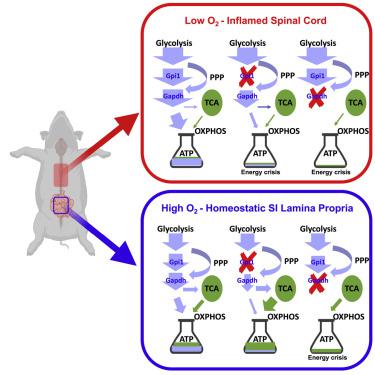Cell ( IF 64.5 ) Pub Date : 2020-07-01 , DOI: 10.1016/j.cell.2020.06.014 Lin Wu 1 , Kate E R Hollinshead 2 , Yuhan Hao 3 , Christy Au 4 , Lina Kroehling 5 , Charles Ng 5 , Woan-Yu Lin 5 , Dayi Li 5 , Hernandez Moura Silva 5 , Jong Shin 6 , Juan J Lafaille 7 , Richard Possemato 6 , Michael E Pacold 2 , Thales Papagiannakopoulos 6 , Alec C Kimmelman 2 , Rahul Satija 3 , Dan R Littman 8

|
Targeting glycolysis has been considered therapeutically intractable owing to its essential housekeeping role. However, the context-dependent requirement for individual glycolytic steps has not been fully explored. We show that CRISPR-mediated targeting of glycolysis in T cells in mice results in global loss of Th17 cells, whereas deficiency of the glycolytic enzyme glucose phosphate isomerase (Gpi1) selectively eliminates inflammatory encephalitogenic and colitogenic Th17 cells, without substantially affecting homeostatic microbiota-specific Th17 cells. In homeostatic Th17 cells, partial blockade of glycolysis upon Gpi1 inactivation was compensated by pentose phosphate pathway flux and increased mitochondrial respiration. In contrast, inflammatory Th17 cells experience a hypoxic microenvironment known to limit mitochondrial respiration, which is incompatible with loss of Gpi1. Our study suggests that inhibiting glycolysis by targeting Gpi1 could be an effective therapeutic strategy with minimum toxicity for Th17-mediated autoimmune diseases, and, more generally, that metabolic redundancies can be exploited for selective targeting of disease processes.
中文翻译:

通过靶向代谢冗余来选择性抑制致病性 Th17 细胞。
由于其重要的管家作用,靶向糖酵解已被认为在治疗上是棘手的。然而,尚未充分探索各个糖酵解步骤的上下文相关要求。我们表明,CRISPR 介导的小鼠 T 细胞糖酵解靶向导致 Th17 细胞的全局损失,而糖酵解酶葡萄糖磷酸异构酶 (Gpi1) 的缺乏选择性地消除了炎症性脑炎和结肠炎 Th17 细胞,而不会显着影响稳态微生物群特异性Th17 细胞。在稳态 Th17 细胞中,部分阻断Gpi1的糖酵解失活被戊糖磷酸途径通量和增加的线粒体呼吸补偿。相比之下,炎症性 Th17 细胞经历了一种已知会限制线粒体呼吸的低氧微环境,这与Gpi1的丢失是不相容的。我们的研究表明,通过靶向 Gpi1 抑制糖酵解可能是一种有效的治疗策略,对 Th17 介导的自身免疫性疾病的毒性最小,更一般地说,代谢冗余可用于选择性靶向疾病过程。



























 京公网安备 11010802027423号
京公网安备 11010802027423号